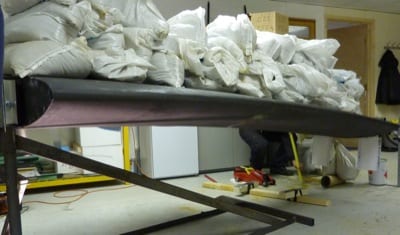
The e-Go project recently passed a milestone with the successful completion of the structural test on the wing.
The e-Go is designed to be able to make a 5g maneuver (5 times the force of gravity) at its maximum dive speed of 150 kts. Two safety factors are then added in when testing the wing, which take the total load applied to 11.25g. So the wing (which weighs 31 lbs.) was tested with a load of 1,874 lbs.
The wing withstood this load, proving the methods used to analyze the structure, company officials said, noting the focus now is on completing the prototype aircraft.

The e-Go’s story began in 2007, when the UK’s Civil Airworthiness Authority decided to de-regulate light aircraft within some tight design parameters. Then the Light Aircraft Association organized a design competition for aircraft that would meet this new class. The category was won by Cambridge aeronautical engineers Giotto Castelli and Tony Bishop with their e-Go design.
Since then, many experts have joined the Cambridge-based project, including Cambridge University research staff and students, specialists from local aerospace companies, pilots and light aircraft builders. About 20 people are now contributing to the project.
The e-Go uses carbon fiber, foam and other advanced materials to achieve high strength and performance with exceptionally low weight. It will cruise at over 100 knots (115 mph) for 400 miles. It will climb at about 1,100 feet per minute and take off from short grass strips, developers say.
For more information: e-Go.me
